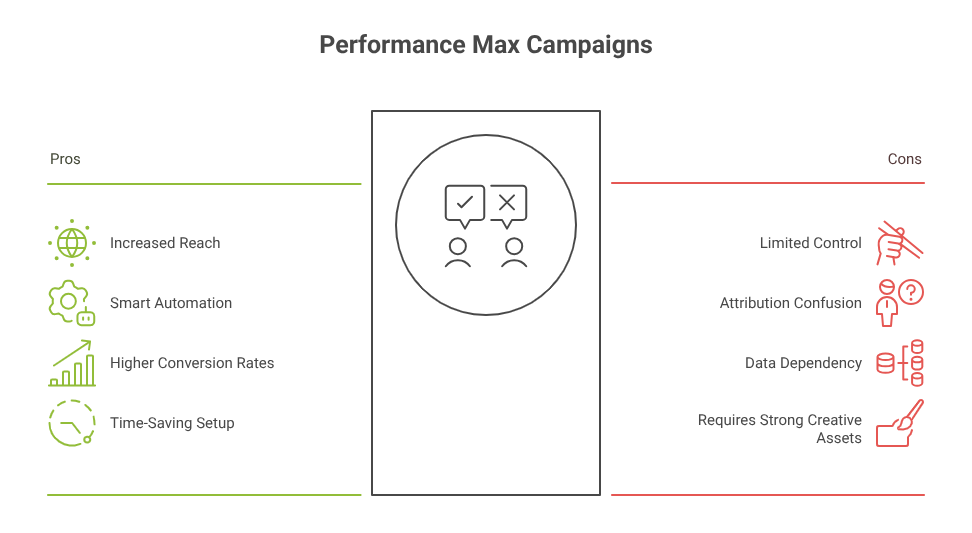In the fast-paced world of digital advertising, marketers are always looking for smarter ways to maximize ROI with minimal complexity. That’s where Google’s Performance Max Campaigns come in. Launched with a promise to simplify ad management while supercharging results, Performance Max has grown from a buzzword to a centerpiece in many Google Ads strategies.
But in 2025, with evolving AI tools, privacy regulations, and ever-changing consumer behavior—is Performance Max still worth your budget
What Are Performance Max Campaigns?
Performance Max (or PMax) is a goal-based campaign type in Google Ads that uses Google’s AI to show your ads across all its platforms from Search, YouTube, Display, Discover, Gmail, and Maps—all within a single campaign.
Rather than manually setting up separate campaigns for each channel, PMax streamlines the process by using machine learning, automation, and real-time data to optimize where your ads appear.
Key Features:
- All-in-one access to Google’s ad inventory
- AI-driven bidding and targeting
- Automated asset testing (headlines, images, videos, etc.)
- Real-time optimization for conversions
- Audience signals to guide learning
What’s New with Performance Max in 2025?
Over the past year, Google has continued to enhance PMax with more transparency, controls, and performance insights, responding to advertiser feedback.
1. More Reporting Clarity
Advertisers now get clearer visibility into which assets, audiences, and channels are driving performance. This helps marketers better understand where their money is going.
2. Better Creative Testing
Google’s asset group testing is now more refined. You can see what combinations of creatives are most effective and make informed creative decisions faster.
3. Integration with First-Party Data
Performance Max now works more seamlessly with first-party CRM and offline data, helping improve targeting accuracy in a cookie-less environment.
Why Marketers Still Love Performance Max
Despite initial hesitations, many marketers have embraced PMax—and here’s why:
1. Increased Reach
With one campaign, your ads show up everywhere Google operates. This increases brand visibility without creating channel-specific campaigns.
2. Smart Automation
Let Google do the heavy lifting—PMax uses AI to optimize bids, placements, and creatives based on live conversion data.
3. Higher Conversion Rates
When properly set up with clear goals, quality assets, and accurate data, PMax can outperform traditional campaigns in both lead generation and e-commerce.
4. Time-Saving Setup
PMax is ideal for businesses with small teams or limited time. One campaign. All channels. Less manual work.
Performance Max: What You Should Watch Out For
No tool is perfect—and that includes PMax. Before going all in, here are some important caveats:

1. Limited Control
Google makes most of the decisions for you. If you’re a marketer who loves tweaking bids and placements manually, this could feel frustrating.
2. Attribution Confusion
Performance Max often overlaps with other campaigns, making it hard to pinpoint exactly where conversions are coming from.
3. Data Dependency
The more data you feed it, the better it performs. Smaller businesses without enough historical conversion data may see inconsistent results.
4. Requires Strong Creative Assets
If you don’t provide high-quality headlines, images, videos, and calls-to-action, PMax won’t work its magic. Bad input = bad output.
When Should You Use Performance Max?
Here’s when PMax might be a smart move in 2025:
| Scenario | Should You Use PMax? |
|---|---|
| You want to simplify your ad setup | ✅ Yes |
| You run e-commerce or lead-gen campaigns | ✅ Yes |
| You have solid creative assets and goals | ✅ Yes |
| You need full manual control | ❌ Probably Not |
| You’re in a niche market with complex audiences | ⚠️ Test with caution |
Pro Tips to Get Better Results with PMax
- Use audience signals: These help Google’s AI learn faster and target more accurately.
- Upload varied assets: Mix videos, square images, long headlines, short CTAs, and more to test combinations.
- Integrate conversion tracking: Without proper tracking (and value-based bidding), PMax won’t deliver optimized results.
- Exclude branded search when needed: To avoid cannibalizing your own brand campaigns, consider exclusions.
- Review placement reports (when available): Keep an eye on where your ads appear to spot waste.
Real Results: What Advertisers Are Saying
Businesses in e-commerce, real estate, and local services have reported:
- 20–40% increase in conversions
- Lower cost-per-acquisition (CPA)
- Higher ROAS (Return on Ad Spend) when using PMax alongside smart segmentation and strong creative assets
Still, results vary by industry and setup—testing is key.
Final Verdict: Are Performance Max Campaigns Worth It in 2025?
Yes—if used strategically.
Performance Max is no longer just a flashy Google experiment. It’s a mature, AI-powered campaign format that can drive serious results—if you feed it clean data, creative assets, and clear goals.
If you’re looking to scale, reach new customers, and streamline your campaigns, Performance Max deserves a spot in your 2025 Google Ads playbook.

